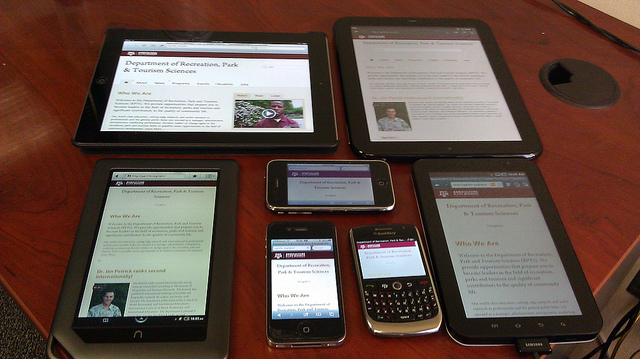Pierre Delforge, Director, High Tech Sector Energy Efficiency, San Francisco
If you’re the lucky recipient of the latest electronic gadgets this holiday season—or live in the same household—you may soon discover that gift comes with a price because today’s TVs, computers, video game consoles, and other devices can generate Santa-sized drains on electricity all year long. Fortunately, a few simple changes can help trim your energy costs.
Not only will you save money on your utility bill, you’ll also prevent the generation of unnecessary electricity and the millions of tons of pollution when power plants make it. Here are some easy tips on how to minimize the electricity use of your devices.
The right settings for your TV: Although many new big-screen televisions use far less energy when powered on than models manufactured even five years ago, they can still waste lots of energy. In the picture set-up menu, choose the “home” or “standard” screen setting—the “vivid” or “retail” settings are unnecessarily bright for most home use and, more important, they burn 15 percent to 20 percent more energy. While you’re in the main menu, also disable the “quick start” function. Most TVs sip just enough juice in standby to recognize your remote control signal to power up and while the quick-start function turns on the TV slightly faster, it can eat a lot more power in standby during the 20 or so hours per day you aren’t using your TV.
Set-top cable and satellite boxes run at near full power even when “off”: More than 85 percent of households are pay TV subscribers and have one or more set top boxes from their cable, satellite, or telephone company. The industry has made some big improvements in the energy use of their boxes, with more coming soon. But for now, ask your cable or satellite provider for a box that meets at least ENERGY STAR® version 4.1 to make sure you have one of the latest, most efficient models. Connecting pay TV service to multiple televisions? Request a whole-home DVR for your primary TV and a “thin client” for the other sets. This eliminates the need for another larger box or DVR, cutting overall energy use and you can still watch recorded shows on any TV. And don’t forget to unplug the set-top box on seldom-used TVs (such as in guest rooms and vacation homes).
Movie magic: If your new TV is internet-ready, you can stream a movie from Netflix directly without another device. If it’s not, the next best thing is to access movies through a small device such as Roku, Chromecast, or Apple TV, which use less than 5 watts. Avoid streaming movies through game consoles like the PlayStation or Xbox because they use 10 to 20 times more energy to play the exact same movie.
Shut off the game console or let it sleep: Failing to turn off the console after playing a game or movie wastes lots of electricity—up to $75 worth annually, which after five years is about what you paid for it. Set the device to put itself to sleep when it’s not being used by going into settings menu and enabling the “auto power down” feature to kick in after one hour of inactivity when a game is loaded, and four hours to allow for movie play.
Let your computer nap, too: Today’s desktop computers and laptops come with excellent power management features that result in very low levels of standby power while maintaining the ability to quickly wake when you return. Don’t disable these settings, but do avoid having a slide show or screen saver continuously running when you’re not there to watch it. A typical desktop computer and monitor running 24/7 unnecessarily uses $40 a year more in electricity than when the devices are put to sleep. The U.S. Environmental Protection Agency recommends adjusting power options for the monitor or screen to turn off after 15 minutes or less of inactivity and for the computer to go to sleep after 30.
Get an ENERGY STAR modem or router: To connect your new computer, tablet, or TV to the internet, you need a router and a modem. An NRDC study found these devices consume about $1 billion in electricity annually. If you’re in the market for a new modem or router, buy one with the ENERGY STAR label and it will use roughly 30 percent less energy.
Don’t forget the thermostat and water heater: A new furnace or water heater may not be traditional holiday gifts, but their settings make a difference on your energy bill. A programmable thermostat can save a few hundred dollars a year by ensuring your furnace or air conditioner isn’t running when you’re away. Make thermostat settings reflect your usual schedule and when it varies, you can temporarily override them for a day without losing them. Also make sure your gas or electric water heater doesn’t work harder than necessary. If water from the tap scalds your hand, the water heater setting is too high. Not only do you risk injury, you waste money. Turn it way down when you’re going to be away for more than a few days.
Out with the old, in with the new: Now that you own the latest gadget, what should you do with the old version? The manufacture of smart phones, tablets and laptops can represent up to 80 percent of their total energy footprint so it often can be better for the environment to keep an old device in service a bit longer. Give an older unit to family or friends or engage in buybacks offered by numerous websites. But if the old device no longer works or is an energy guzzler, take it to a recycler. Best Buy accepts old electronics, including TVs, at its stores for free, no matter where the devices were purchased. Staples has a similar program for office equipment but doesn’t take old TVs.
Here’s a one-page guide that explains it all:








